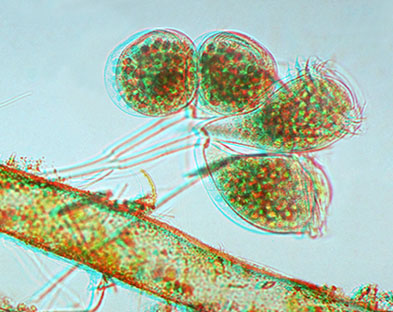
this page should be viewed with red and blue 3D glasses
| Bell animalcules | |||
Campanella umbellaria |
|||
|
| Bell
animalcules are tiny unicellular organisms that belong to
a group called the ciliates. Well known ciliates are the
slipper animalcules of the genus Paramecium.
Vorticella, the best known bell
animalcule has a stalk that contracts in a spiral. Carchesium
(see background image) does the same but lives as a
colony. The bell animalcules of the genus Campanella
also form a colony but can be recognized by the bells
that contract and not the stalk. The 3D photograph shows
two contracted bells.The stalk is kept stretched. These animals, like many ciliates, can be found in waters rich of bacteria. With their rows of cilia (Campanella has more rows than other bell animalcules) they transport the food into a body opening on the side. The food is transported in a vacuole through the cell. When the environment becomes inhospitable the creature can grow a ring of cilia around the lower part of the cell and swim away. |
THE INSTITUTE FOR THE PROMOTION OF THE LESS THAN ONE MILLIMETRE
![]()
![]()
Comments to the author Wim van Egmond are welcomed.
All Material Copyright: © Wim van Egmond
Please report any Web problems
or offer general comments to the Micscape Editor,
via the contact on current Micscape Index.
Micscape is the on-line monthly
magazine of the Microscopy UK web
site at Microscopy-UK